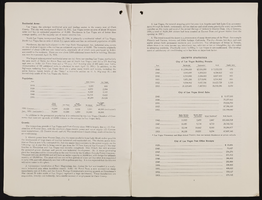Search the Special Collections and Archives Portal
Search Results


Transcript of interview with Eddie E. Buxton by Bernard D. Vardiman, March 30, 1976
Date
1976-03-30
Archival Collection
Description
Bernard Vardiman interviews colleague Eddie Buxton (born 1938 in Las Vegas, Nevada), an officer with the North Las Vegas Police Department, about his family heritage and his experiences growing up in Las Vegas. Buxton describes the significance of some of his ancestors, from Rose Warren, who was one of the first Las Vegas pioneers, to Joe and Ernest May, two of the first police officers in Las Vegas. He specifically mentions the 1933 death of Ernest May, the first law enforcement officer in Las Vegas killed in the line of duty. Buxton also recalls the development of both Las Vegas and North Las Vegas over time, including specific locations and what used to be undeveloped land. He also describes going to school in the city, his father’s work on Hoover Dam, and other aspects about the way of life in Las Vegas.
Text

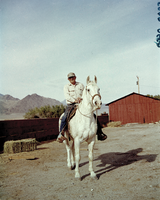
Phil Tobin on horseback: photographic film
Date
1960 (year approximate) to 1986 (year approximate)
Archival Collection
Description
Phil Tobin posing on a white horse at an unknown location. In 1931, as a freshman Assemblyman, Phil Tobin introduced a bill to legalize gambling in Nevada. A Humboldt County rancher and buckaroo, the 29-year old had no interest in gambling himself. Instead, he correctly believed legalized gambling would benefit the public and especially schools thanks to tax revenues. At the time, illicit gambling houses were thriving in Las Vegas, and with Hoover Dam slated to begin construction 40 miles away, many feared the increased Federal presence associated with the Dam construction effort would lead to a clamp-down. The measure passed. After serving out his term, Tobin returned to ranch life for good.
Image

Transcript of interview with Lyla Joy Ford by Anne Cope, March 12, 1975
Date
1975-03-12
Archival Collection
Description
On March 12, 1975, Anne Cope interviewed Tropicana Hotel decorator, Lyla Joy Ford (born December 12, 1928 in Las Vegas, Nevada) in her home in Las Vegas. During the interview, Ford discusses social life in Las Vegas in the early days. She mentions the Palace Theatre, which became the Guild and the El Portal Theatre. She recalls Sammy Davis Jr. performing at the El Rancho but states that people of color were not allowed in the audience. She remembers the Helldorado Parade as a big western celebration. Her family used to own the Old Ranch, also known as the Stewart Ranch. She states that the railroad, Hoover Dam, and the Basic Magnesium Plant brought money into Las Vegas. She also recalls the atomic tests and witnessing the city’s gradual transformation from a small farming town to a major gambling city.
Text
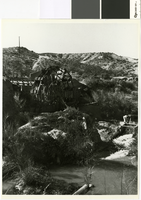
Photograph of waterwheel on the Muddy River near Logandale, Nevada, January 21, 1947
Date
1947-01-21
Archival Collection
Description
38 foot waterwheel on the Muddy River near Logandale, Nevada.
Transcribed Notes: Bureau of Reclamation typed notes appended to back of photo: Boulder Canyon Project, Nevada Region 3 A 38-foot water wheel lifts water 30 feet from the Muddy River to irrigate a farm near Glendale, Nevada.
Image
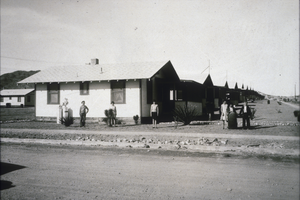
Slide of a cottage built by Six Companies, Boulder City, Nevada, January 7, 1932
Date
1932-01-07
Archival Collection
Description
Black and white image of children standing outside of a cottage (similar to 450 others in the area) built by Six Companies, Inc. for their married employees in Boulder City. Many residents planted cactus and other shrubs indigenous to the area in their lawns.
Image
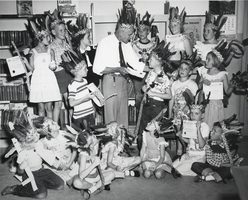
Photograph of the summer program at the Boulder City Library, Nevada, August 31, 1951
Date
1951-08-31
Archival Collection
Description
Black and white view of a man standing with a group of children participating in a summer recreation program entitled "Let's Play Indians" in the Boulder City Library, which was located in the basement of the city's municipal building. The man and children are all wearing feathered headpieces.
Image
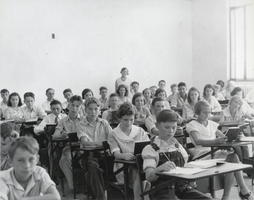
Photograph of Boulder City Elementary School, Boulder City, Nevada, October 5, 1932
Date
1932-10-05
Archival Collection
Description
Black and white image of the first eighth grade class of Boulder City Elementary School, currently the home of City Hall, located at 401 California Avenue in Boulder City. The principal of the school, Miss Leila Tilley, is visible in the back of the classroom behind the students.
Image
Pagination
Refine my results
Content Type
Creator or Contributor
Subject
Archival Collection
Digital Project
Resource Type
Year
Material Type
Place
Language
Records Classification

